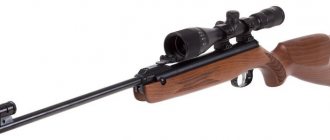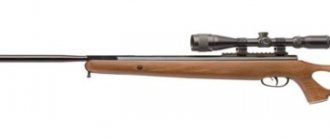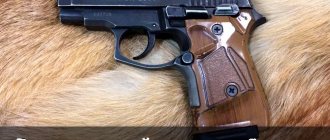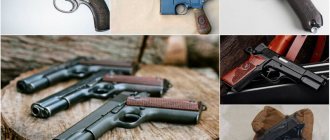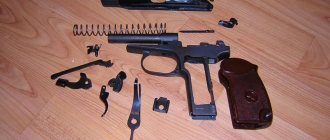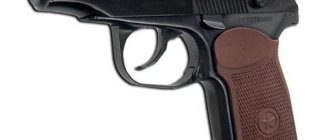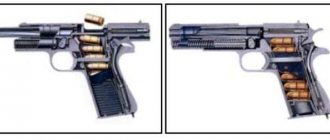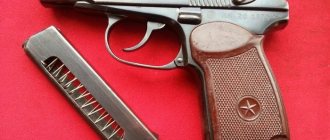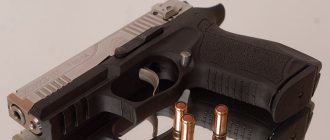American firearms manufacturer
Hi-Point Firearms Company
| Type | Private |
| Industry | Firearms |
| Based | February 18, 1992, Flint, Michigan, USA. |
| Headquarters | Mansfield, Ohio , us |
| Key people | President: Mike Strassel |
| Goods | Pistols, carbines |
| Parent | Strassell's Machine, Inc. |
| Web site | www.hi-pointfirearms.com |
| In this article too many links to primary sources . |
Hi-Point Firearms
, also known as
Strassell's Machine, Inc
(distributed by
MKS Supply
), is an American firearms manufacturer based in Mansfield, Ohio. All of their firearms are manufactured in multiple locations in Ohio.
History of the pistol
The idea of a blowback pistol chambered for high-pressure cartridges dates back to the early 20th century. Several designers tinkered with the concept, and while most products were not successful, others made history in modern pistols.
The first to note is the Spanish Campo-Giro 1913-16, which was chambered for the powerful 9mm Largo cartridge. It was followed by Astra 400 and 600 pistols, firing the same cartridge. Lesser-known models include the Beretta 1915-19 and 1923 (9mm Glisenti); German Dreyse Heeres Pistole and Walther Mod. 6 (9mm Parabellum); and the Danish Schouboe, which used a unique 11.35 mm wooden bullet cartridge.
All of these pistols used very heavy recoil springs to hold the bolt forward until chamber pressure dropped to a safe level, and large, heavy frames to absorb recoil energy. This led to the bulkiness of the weapon, the difficulty of its maintenance and short service life.
For the past three decades, Hi-Point Firearms has offered blowback pistols and carbines chambered in .380 ACP, 9mm Parabellum, .40 S&W and .45 ACP. Hi-Point was one of the first American manufacturers to use polymer frames in firearm construction. In 1992-93, the company released 9mm polymer pistols, then .380-caliber weapons, and finally .40- and .45-caliber pistols.
And it worked. Polymer provides many benefits to the shooter, such as reduced recoil, ease of maintenance, and longer life. Polymer is inherently lighter than steel or alloy and is therefore easier to maintain, requiring less gun lube, etc.
We recommend studying: TT pistol
Hi-Point. Functionality instead of elegance
Here in North Carolina we have a saying: "It's as ugly as if it fell from the top of the gnarliest tree without missing a branch." Keeping this statement in mind, I have no doubt that none of the readers will consider the subject of this article to be a model of grace. However, it was not made for beauty.
The idea of a pistol chambered for fairly powerful cartridges, using the simplest automatic blowback design, is by no means new and dates back to the beginning of the twentieth century. Many designers tried this idea, and although not all such systems turned out to be successful, some of them still left their mark on history. Perhaps the first such pistol was the Spanish Campo-Giro M1913-16, created for the rather powerful 9 mm Largo cartridge (9x23 Bergmann-Bayard). It was followed by the Astra 400 pistols chambered for the same cartridge and the slightly smaller Astra 600 chambered for the 9x19 Luger cartridge. Less successful were the Beretta M1915-19 and M1923 pistols chambered for 9mm Glizenti and the German Dreyse and Walther Mod.6, both 9x19 caliber.
All of these pistols had powerful bolt recoil springs to keep the cartridge case in the chamber while barrel pressure was still high, as well as massive frames that could withstand fairly harsh recoil. With the exception of the Spanish Astra pistols, most of these pistols had rather problematic reliability.
For the last ten or so years, Ohio-based Hi-Point Firearms has been offering blowback pistols chambered in 9x17 Browning (.380ACP), as well as 9x19 Parabellum, .40 SW and even .45 ACP cartridges on the American market. In order to understand what these pistols are like, I was given two of the most popular models of the Hi-Point line for testing - the JCP model in .40 SW caliber and the JHP model in .45A CP caliber. When I opened the boxes that were delivered to me, my first thought was, “Um... these really don't look like the others.” These were probably the weirdest looking pair of pistols I've seen in years.
The first thing that catches your eye is the very massive rectangular-section gates, which have large windows on the right for ejecting cartridges. These valves are made of cast aluminum-zinc alloy, with reinforcing steel liners in the area of the valve mirror and other critical areas. When I asked Hi-Point employee Charlie Brown about the reasoning behind this design, he replied, “Hi-Point pistols are designed to keep costs as low as possible. There are several large manufacturing facilities located near us in Ohio that produce casting parts for the automotive industry. We use this resource and our pistols work well with all standard types of ammunition.”
Interestingly, Hi-Point was one of the first in the US arms industry to use polymers to make pistol frames. In 1992-93, the company released 9x19 caliber pistols with polymer frames, followed by 9x17 caliber pistols, and only then .40 and .45 calibers. The polymer frame provides a lot of positive qualities - reduced recoil, reduced need for weapon maintenance, increased survivability.
Polymer frames of Hi-Point pistols are produced integrally with a trigger guard and a guide for mounting an under-barrel flashlight or laser sight. The barrel is rigidly and permanently mounted in the frame, and the return spring is located under the barrel. The cheeks of the handle are made in the form of separate parts and are attached to the frame with screws.
The design of Hi-Point pistols is designed in such a way that the main force opposing the opening of the bolt is its own mass, or more precisely, its inertia; therefore, the return spring has a relatively low stiffness. This makes the Hi-Point action easy to reset for almost any shooter, including women.
Hi-Point pistols use a striker-fired, single-action (non-self-cocking) firing mechanism. The manual safety device, located on the left side of the frame, blocks the sear when turned on.
The controls on both pistols are located quite conveniently. The trigger and magazine release release are easy and without discomfort. The manual safety provides a secure lock in any position, but its lever is small, and turning the safety on and off requires some adjustment to the grip of the weapon.
The pistols are equipped with single-stack magazines that hold 9 rounds of .40 caliber or 10 rounds of .45 caliber rounds. The magazine bottoms are equipped with massive plastic linings that protect the magazine when dropped on a hard surface. The design of the magazine shaft ensures that the magazine falls freely after its latch, located on the left at the base of the trigger guard, is turned off, which in a critical situation allows for faster reloading of the weapon. Y-P0int pistols have a simple magazine safety that blocks the trigger when the magazine is removed. Like most modern pistols, the Hi-Point has a slide stop that locks the bolt open once all the rounds in the magazine have been used up. However, the delay does not have an external switch, so after changing the magazine, the open bolt must be pulled back slightly and released, allowing it to close and send the cartridge into the chamber.
Sights are one of the undoubted advantages of Hi-Point pistols. They include a front sight integral with the bolt, a small aiming bar along the entire length of the aiming line, and a non-adjustable rear sight. The front and rear sights have contrasting Day-Glo inserts in bright orange in the form of three dots - one on the front sight and two on the rear sight. This improvement to a conventional sight greatly helps with targeted shooting, especially offhand shooting. Bright dots are clearly visible against almost any background and allow you to quickly align your sight.
The descent also does not cause any complaints. My dynamometer showed a non-self-cocking trigger pull of just under 4 lbs (1.8 kg) with a slight trigger play and a crisp, dry trigger.
Despite their, to put it mildly, peculiar appearance, Hi-Point pistols have good balance and comfortable grips. The shape of the handle promotes instinctive aiming.
Partial disassembly of Hi-Po-int pistols is quite simple. After removing the magazine, the bolt is pulled back as far as it will go and secured in this position with the safety lever. After this, a cross pin is knocked out from the back of the frame with a punch, then the bolt is removed from the safety lock and smoothly brought to the front position. Then the bolt is pulled back again by about 10 mm, its rear part is lifted from the frame guides, after which the bolt is removed from the barrel forward.
I have no doubt that many readers have already drawn conclusions about the unreliability of the Hi-Point based solely on its unsightly appearance. I can understand them, but I do not agree with their conclusions. A long time ago I read the “Pros and Cons” article about "Saturday Night Special" revolvers (an American term for the cheapest, disposable weapons - translator's note). While the opponent of these revolvers argued that they were the weapon of choice for the marginalized, their defender argued that these cheapest examples were often the only weapon of self-defense , which was within the means of their owners.
Brown told me that the main reason Hi-Point pistols came to market was to give the average worker the opportunity to buy a decent quality gun, made in the USA, and at the most affordable price: “Too many gun manufacturers position themselves well beyond the average wallet. American. We talk every day with customers who have purchased Hi-Points and use them for self-defense, hunting, etc. One professional fisherman said that he uses our .45 caliber pistol to finish off his halibut before hauling it into the boat. A professional game warden said that when he takes his clients bowhunting for big game, he makes sure to give each one a .45 Hi-Point.”
Let's be honest. You don't have to spend a ton of money to purchase a gun to protect your home. Self-defense weapons must meet a number of basic requirements, such as: reliability in operation and safety in handling; be powerful enough (use sufficiently effective ammunition); Finally, it must provide adequate shooting accuracy at typical ranges. If your weapon meets these conditions, it doesn't matter whether it costs $100 or $1,000.
It should be noted that the Hi-P01nt pistols performed surprisingly well in shooting. Despite the fairly powerful cartridges and primitive automatic action with a blowback bolt, the recoil of the pistols was quite soft, although it felt unusual due to the large mass of the bolt. Firing accuracy was also quite adequate for a self-defense weapon - when fired hand-held at a range of 15 yards (13.6 meters), groups of 5 shots fit into a circle with a diameter of 3 inches (76 mm). In addition, during the tests, both pistols “eat” more than 200 rounds of ammunition from a variety of manufacturers and with a variety of types of bullets (jacket, expanding) without a single delay or misfire.
Overall I was impressed with this weapon. If you want a weapon that can put a big hole in the bad guy when necessary without first blowing a bigger hole in your budget, then you should definitely look at Hi-Point pistols. Yes, they are unlikely to be suitable for concealed carry, and you are unlikely to show them off to friends or acquaintances. However, at the right time you will have a serious weapon. Remember, it is not the appearance or price tag of the gun that hits the target, but the bullet fired from it.
From the editor:
It should be noted that in the American consciousness the Hi-Point pistol is given a place somewhat comparable to the place of the old “humpbacked” Zaporozhets, which seemed to have a car and drive, but it looked somehow completely ridiculous... But it gave to the poor people who are independent from others have the opportunity to move independently in space. So does Hi-Point. These weapons also give poor Americans the opportunity to independently protect themselves, their loved ones, and their homes, because the retail price of these pistols (120-150 US dollars; the price of pistols like Glock, Beretta or Smith & Wesson usually starts at $500 and above) is low even by Russian standards and is quite comparable to the price of a Makarov pistol. Of course, our native PM is much more elegant and compact, and, most likely, more durable and reliable, but Hi-Point uses significantly more effective large-caliber cartridges, increasing the likelihood of hitting a target with the first shot. We can only wish that not only ordinary Americans, but also ordinary Russians would have the opportunity to buy, if not the most elegant and sophisticated, but a truly effective and inexpensive means of self-defense. We have no doubt that a domestic manufacturer could well master the production of similar types of weapons, because even .40SW and .45ACP cartridges are already produced in our country, but bad luck - only for export... So, by and large, the matter is small, ours legislators who still don’t want to entrust ordinary people with truly reliable and effective means of self-defense - full-fledged pistols and revolvers with full-fledged and time-tested ammunition.
Paul Scarlata
Design features
The High Point polymer frame is equipped with a built-in trigger guard and an auxiliary rail for installing additional attachments (flashlights or laser sights). The barrel is rigidly fixed to the frame, and the return spring is located in a groove under the barrel, where the rear-facing bolt rests on it during recoil.
The success of such a design depends, first of all, on the mass of the shutter. This is to prevent the bolt from moving backward until the pressure in the barrel drops to a safe level.
Unlike the pistols mentioned at the beginning of this article, due to the weight of the bolt, the spring does not need to be as strong, which means it will not hinder manual cocking of the bolt.
The controls on the JCP and JHP pistols are well laid out and the trigger and magazine release button are easy to use. The manual safety, while reliable and secure in any position, is on the small side and a little difficult to operate without moving the weapon in your hand. The .40 caliber JCP comes with a nine-round single-stack magazine, while the .45 ACP pistol comes with a 10-round magazine.
All magazines are equipped with a solid heel to ensure proper installation in the pistol grip and prevent damage when hitting the ground. The large magazine insertion hole (Magwell) allows you to easily reload magazines, and when removing them, they can be easily removed by pressing the reset button - both loaded and empty.
A simple safety, consisting of a steel bar under the right grip panel, blocks the trigger to prevent the firing pin from being released.
Features of inexpensive pistols
In addition to the excellent combination of price and quality of pneumatics, buyers can familiarize themselves with the technical characteristics. Guns are selected for their intended purpose: shooting at clay pigeons, training inexperienced users, constant carrying or protection of the owner. World-famous replica firearms are made using identical designs, and the cost reduction is achieved through a combination of plastic and metal.
What to look for when buying a cheap pistol:
- the power of models is less than 3 J, which makes it possible not to obtain a license;
- high similarity to the original weapon;
- you can choose models with the Blowback system;
- the presence of Weaver strips on many samples, that is, the possibility of installing a canopy;
- initial speed 70-129 m/s;
- you can choose a rifled or smoothbore pistol;
- ammunition consists of balls and bullets of 4.5 mm caliber.
The pistols fit well in the hand and are equipped with a comfortable grooved grip, so the shooter does not get tired. Quite often, budget options become the owner’s main air pistol, as they fully meet the requirements.
Operating principle
The structure of a pistol with a hidden trigger
Hi-Point pistols are short-barreled striker-type weapons (a pistol with a hidden trigger) that use a single-action trigger mechanism. The thumb safety on the left side of the frame blocks the sear when turned on. To provide additional protection, the design includes a spring-loaded block that fits under the sear lever and prevents the firing pin from accidentally striking the primer when the pistol is dropped.
Like most semi-automatic pistols, the Hi-Point slide is locked in the rear position when the magazine is empty, but the weapon does not have a slide release device. Thus, the magazine must be removed (or a loaded magazine inserted if you intend to continue shooting) and the bolt must be pulled back slightly to release the internal lock. After this, the bolt will be released from locking and you can continue shooting.
Powerful air guns at affordable prices
Among all the weapons that are actually used for professional activities and self-defense, pneumatic weapons should be highlighted. The most powerful ones require a license, but there are also publicly available models that every citizen of our country can purchase and use for their own purposes. Most often they are purchased for the purposes of self-defense and entertainment, for example, for shooting training. At the same time, before making a choice in favor of one or another weapon model, you should determine its technical characteristics:
- Range and firepower.
- Caliber.
- Barrel length.
- Dimensions and weight.
- Download and setup.
In other words, before buying an air pistol, you need to decide on the model of the weapon and its characteristics.
Assembling and disassembling the pistol
Field disassembly for normal maintenance is fairly simple.
- First, remove the magazine and pull back the bolt to ensure the chamber is empty.
- Then move the bolt to the rearmost position, slide the manual safety up in the small front notch and lock into place.
- The bolt release pin at the rear of the frame is now visible through the large (rear) safety notch in the bolt. Using a punch, remove the locking pin from the frame.
- Remove the weapon from the safety and move the bolt forward. Pull it back a little and pull it up.
- Grasp the rear of the bolt and point it forward, lifting it off the frame.
Assembly is carried out in reverse order.
Cartridge 9×17/.380 ACP
The world-famous gunsmith John Moses Browning created the 9x17 mm cartridge for the American company Colt in 1908.
The 9×17 cartridge itself was developed from the 9mm Browning Long cartridge created for the Belgian company FN in 1903.
The 9x17 cartridge case is cylindrical, made of steel, coated with copper or brass (knurling is possible). Projectile bullet with a lead core. The wrapper is typically tombak with a thicker face covering to increase penetration.
The 9x17 mm cartridge has the following characteristics: cartridge weight - 96 grams, bullet weight - from 5.9 to 6.2 grams, muzzle velocity - from 270 to 308 m/s, muzzle energy of the bullet - 224-280 J.
In 1910, the Belgian company FN (Fabrique Nationale) also began producing Browning shotguns for this cartridge, designating it the 9mm Browning Short.
In the USA, this cartridge appeared under the designation .380 ACP. 9×17 Between World Wars I and II, the 9×17 cartridge gained popularity on both continents as police and civilian ammunition in models such as the 1910 and 1922 FN-Browning pistols, Colt's "pocket model". Later, such guns as Walter PP, Mauser HSc (HSc), Colt “Mustang” and “Officer Model”, FN Model 140 and many others were produced for this ammunition.
On the basis of the 9 × 17 cartridge, the Soviet 9 × 18 PM cartridge was also developed.
In Russia, the 9x17 cartridge has been produced since 1996 at the Tula Cartridge Plant and is known as 9x17 mm K.
After certification of the 9x17 cartridge in Russia, it was adopted and became a modification of the PM pistol under the designation IZH-71, and a number of pistols and revolvers are produced for it.
Performance characteristics
| Model | Hi Point JCP .40 S&W |
| Manufacturer | Hi Point Firearms Co. |
| Principle of operation | Automatic blowback recoil |
| Caliber | .40 S&W |
| Magazine capacity | 9 rounds |
| Barrel length | 4.5 inches |
| total length | 7.72 inches |
| Weight without magazine | 907.185 |
| Sights | Three-dot sighting device |
| Fuse | Manual thumb safety |
| Finishing | Black powder coating |
| Price | 169$ |
Links[edit]
- “Hi-Point pistols: simple, but so reliable!” . Shooting time
. 2007. Archived from the original on February 14, 2009. - "Hi-Point Firearms: 380ACP Pistols - Black". www.hi-pointfirearms.com
. - "Hi-Point Firearms: 9mm Pistols - Black". www.hi-pointfirearms.com
. - "Hi-Point Firearms: 40S&W Pistols - Black". www.hi-pointfirearms.com
. - "Hi-Point Firearms: 45ACP Pistols - Black". www.hi-pointfirearms.com
. - "Hi-Point Firearms: 380ACP Carbines - Black". www.hi-pointfirearms.com
. - "Hi-Point Firearms: 9mm Carbines - Black". www.hi-pointfirearms.com
. - "Hi-Point Firearms: 10mm Carbines - Black". www.hi-pointfirearms.com
. - "Hi-Point Firearms: 45ACP Carbines - Black". www.hi-pointfirearms.com
. - "Hi-Point C9 - RECALL". October 25, 2010
- “Hi-Point pistols: simple, but so reliable! - Shooting time." October 6, 2005
Reasons why the Hi-Point pistol is cheap
The weapons company Hi-Point is known, first of all, for its affordable prices for its weapons. Thus, the price for a pistol in .40 S&W caliber is $169 (12,500 rubles at the current exchange rate).
The Hi-Point pistol is so cheap because it doesn't have any bells and whistles and has a very simple design. The main parts of the weapon are stamped and machined from steel blanks. They are designed with technology to reduce production costs to the extreme. There are no ergonomic handles or shiny parts in the company's products - just truly durable, reliable construction that can withstand years of intensive use.
Cheap air guns
An inexpensive airgun is ideal for recreational shooting at cans, bottles and targets, and these guns are also ideal for hardball enthusiasts.
Main characteristics of economical air pistols:
- Great resemblance to the original combat prototypes;
- Wide range of practical applications;
- The energy of the muzzle shot does not exceed 3 J;
- Ammunition - bullets and bullets of 4.5 mm caliber;
- Does not require permits;
- There are pistols with a blowback system (moving bolt);
- Weaver bar for attaching additional equipment;
- Semi-automatic firing mode;
- Presence of a fuse;
- The speed at the muzzle of the projectile is from 70 to 129 m/s.
Functional features of economical air pistols
Among the cheap air guns, you can find models with and without the Blowback sliding valve system. Pistols that simulate the movement of the shutter when firing consume more air, but look the most realistic. Even an inexpensive tire for gas cylinders has an initial bullet ejection speed of 70 to 129 m/s, which will allow targeted fire at targets at a distance of up to 15 meters. One gas cylinder is enough for 50-60 shots. Both bullets and explosive balls of 4.5 mm caliber are used as ammunition. Some models have Weaver rails that can accommodate additional equipment.
Design features of economical air pistols
In the range of inexpensive air pistols from different manufacturers, you can find models in both all-metal and plastic casings. The types of barrels used by different brands also vary, smooth barrels are used for bullets and rifled barrels are used for bullets. We advise you to look into the section with accessories and spare parts for pneumatics; there you will find many useful products that can significantly expand the functionality of your weapon. You can also check other popular product categories:
- Air rifles
- Bullets and balls for pneumatics
Results
Hi-Point pistols have a number of serious disadvantages. Firstly, appearance: although this does not in any way affect the shooting efficiency, the weapon should bring aesthetic pleasure to its shooter, because for many, the choice of short-barreled firearms depends not least on appearance. From this point of view, Hi-Point pistols look disgusting.
Secondly, the weapon has extremely mediocre ergonomics, which seriously affects the comfort when shooting a pistol and the shooting efficiency. It is also worth noting that there is no slide stop reset in the design. But all these shortcomings are more than offset by the incredibly low cost of the products and good reliability for this price segment.
Hi-Point guns are designed for real-world use, which means you can put them in your tackle box, your car's glove compartment or trunk, your toolbox or backpack. Hi-Point products are designed to go where few people would want to take their $600+ pistol.
Hi-Point weapons simply have no competitors in their price segment and rightfully occupy their niche in the firearms market. Such products are intended for people who are on a tight budget. It’s not a shame to break or lose such a weapon, but at the same time, with proper maintenance, the weapon can last quite a long time.
ProGuns website will be grateful for your comments, we are waiting for your opinions ↓
Security[edit]
Hi-Point firearms have a manual thumb safety and a built-in drop safety that prevents discharge if the firearm is dropped. Until the 2000s, all Hi-Point products except the 995 (9mm) carbine had a last-shot lock and magazine release safety, which prevented firing if the magazine was not in the gun. With the replacement of the original 9mm carbine with the new Model 995 TS, all pistols and carbines now have these features. [10] [11]
